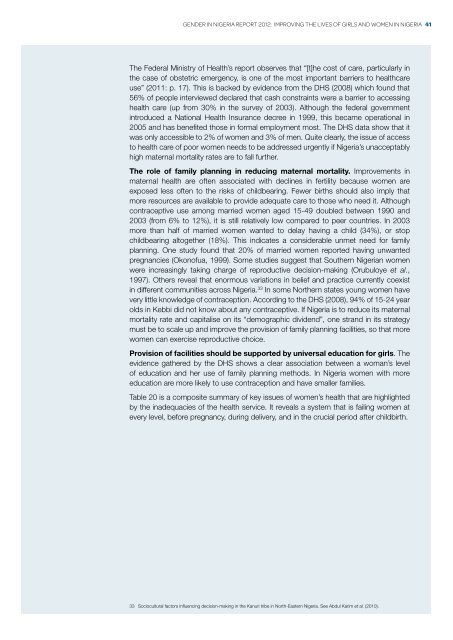Gender in niGeria report 2012 - Economic Commission for Africa
Gender in niGeria report 2012 - Economic Commission for Africa
Gender in niGeria report 2012 - Economic Commission for Africa
You also want an ePaper? Increase the reach of your titles
YUMPU automatically turns print PDFs into web optimized ePapers that Google loves.
<strong>Gender</strong> <strong>in</strong> Nigeria Report <strong>2012</strong>: Improv<strong>in</strong>g the Lives of Girls and Women <strong>in</strong> Nigeria 41<br />
The Federal M<strong>in</strong>istry of Health’s <strong>report</strong> observes that “[t]he cost of care, particularly <strong>in</strong><br />
the case of obstetric emergency, is one of the most important barriers to healthcare<br />
use” (2011: p. 17). This is backed by evidence from the DHS (2008) which found that<br />
56% of people <strong>in</strong>terviewed declared that cash constra<strong>in</strong>ts were a barrier to access<strong>in</strong>g<br />
health care (up from 30% <strong>in</strong> the survey of 2003). Although the federal government<br />
<strong>in</strong>troduced a National Health Insurance decree <strong>in</strong> 1999, this became operational <strong>in</strong><br />
2005 and has benefited those <strong>in</strong> <strong>for</strong>mal employment most. The DHS data show that it<br />
was only accessible to 2% of women and 3% of men. Quite clearly, the issue of access<br />
to health care of poor women needs to be addressed urgently if Nigeria’s unacceptably<br />
high maternal mortality rates are to fall further.<br />
The role of family plann<strong>in</strong>g <strong>in</strong> reduc<strong>in</strong>g maternal mortality. Improvements <strong>in</strong><br />
maternal health are often associated with decl<strong>in</strong>es <strong>in</strong> fertility because women are<br />
exposed less often to the risks of childbear<strong>in</strong>g. Fewer births should also imply that<br />
more resources are available to provide adequate care to those who need it. Although<br />
contraceptive use among married women aged 15-49 doubled between 1990 and<br />
2003 (from 6% to 12%), it is still relatively low compared to peer countries. In 2003<br />
more than half of married women wanted to delay hav<strong>in</strong>g a child (34%), or stop<br />
childbear<strong>in</strong>g altogether (18%). This <strong>in</strong>dicates a considerable unmet need <strong>for</strong> family<br />
plann<strong>in</strong>g. One study found that 20% of married women <strong>report</strong>ed hav<strong>in</strong>g unwanted<br />
pregnancies (Okonofua, 1999). Some studies suggest that Southern Nigerian women<br />
were <strong>in</strong>creas<strong>in</strong>gly tak<strong>in</strong>g charge of reproductive decision-mak<strong>in</strong>g (Orubuloye et al.,<br />
1997). Others reveal that enormous variations <strong>in</strong> belief and practice currently coexist<br />
<strong>in</strong> different communities across Nigeria. 33 In some Northern states young women have<br />
very little knowledge of contraception. Accord<strong>in</strong>g to the DHS (2008), 94% of 15-24 year<br />
olds <strong>in</strong> Kebbi did not know about any contraceptive. If Nigeria is to reduce its maternal<br />
mortality rate and capitalise on its “demographic dividend”, one strand <strong>in</strong> its strategy<br />
must be to scale up and improve the provision of family plann<strong>in</strong>g facilities, so that more<br />
women can exercise reproductive choice.<br />
Provision of facilities should be supported by universal education <strong>for</strong> girls. The<br />
evidence gathered by the DHS shows a clear association between a woman’s level<br />
of education and her use of family plann<strong>in</strong>g methods. In Nigeria women with more<br />
education are more likely to use contraception and have smaller families.<br />
Table 20 is a composite summary of key issues of women’s health that are highlighted<br />
by the <strong>in</strong>adequacies of the health service. It reveals a system that is fail<strong>in</strong>g women at<br />
every level, be<strong>for</strong>e pregnancy, dur<strong>in</strong>g delivery, and <strong>in</strong> the crucial period after childbirth.<br />
33 Sociocultural factors <strong>in</strong>fluenc<strong>in</strong>g decision-mak<strong>in</strong>g <strong>in</strong> the Kanuri tribe <strong>in</strong> North-Eastern Nigeria. See Abdul Karim et al. (2010).

















